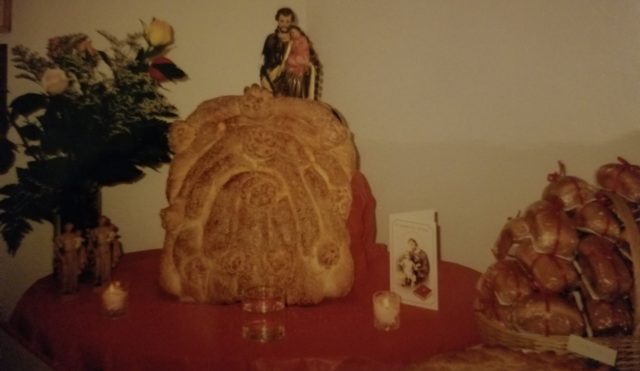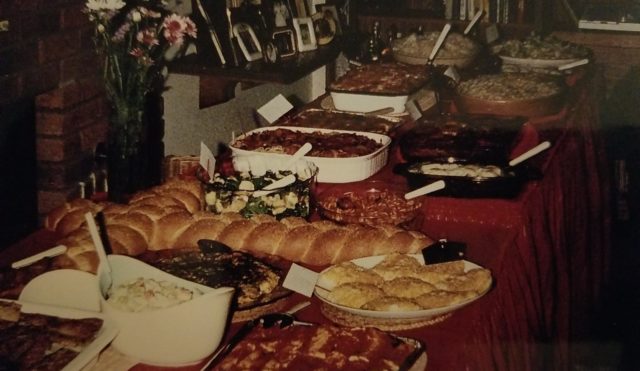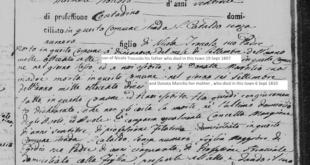The altar my grandma arranges sits under one of our kitchen cabinets. The rosary hangs from St. Joseph’s neck. It’s deep purple with silver pieces between each bead. The statue is about a foot tall and hand painted. He has gray, purple, and brown cloth draped from his body. He’s typically depicted holding Baby Jesus, but in ours he stands alone surrounded by small votive candles.
The tomatoes start to simmer right before guests arrive. Both of my uncles are in the kitchen. Steel pots sit on the stove and emit clouds of steam each time the lids are lifted to stir pasta or gravy. They chop garlic, drain clams, pour olive oil, and cover the fish in breadcrumbs, moving seamlessly together. My grandmother sits on a chair in the corner of our kitchen and watches. She reminds my uncle, a professional chef, to pat the fish dry before breading it.
When my grandmother’s family came over from Sicily they were poor, so their St. Joseph feasts consisted of dishes that could be prepared cheaply like pasta, lentils, and bread. My grandmother has told me of how her mother and aunts arranged their feast on a table that extended throughout several rooms in their Chicago apartment.
Decades ago, when entire families lived on the same street, everyone would leave their doors open or unlocked and move from home to home sampling food from each family’s table. My grandmother’s family would sit on the brick stoops and sidewalk on West Polk Street in Chicago, laughing and eating until the sky grew dark.
Though our table is now smaller, we continue to incorporate the main dishes that are traditionally served for St. Joseph’s Day. Two-hundred pieces of breaded Pollock; bowls filled with cold calamari and chopped octopus tentacles dripping in lemon; pastas swimming in gravy, garlic, and white clams; and the St. Joseph pasta, a dish covered in cauliflower and breadcrumbs to represent Joseph’s wood shavings as a carpenter.
There are loaves of bread positioned around St. Joseph’s altar before they’re cut and served with dinner. The main loaf is a beautifully braided, two-foot cross lightly covered in sesame seeds — a design my aunt Phil made every year and one my papa continued after her hands grew tired of braiding the dough.
We eat scattered throughout the house. My uncles always eat in the kitchen, usually from the scraps in each pot and pan, always making sure everyone else has eaten enough before they do. We do this for hours. Some of us rotate from a chair to the stairs in the foyer in between trips to the kitchen for second and third helpings until there is nothing left.
I often think about the trip my grandmother’s family made across an ocean to come to Chicago from Palermo. They preached the conventional immigrant story: they left to give their children a better life than they had. They left dirt roads and yellowed buildings caked in gray dust. They lived walking distance from the sea that rocked up against dull mountains. I think about what this day would have looked like in their homeland. I imagine their tables full and their voices loud. I wonder if they thought the stoops in Chicago paled in comparison.
Due to crowded schedules and time constraints, we don’t celebrate the day as it once was. I wonder how it’s possible to get back to where we’ve been. To a place where minutes aren’t counted and tables are abundant. Perhaps instead of comparing to the past I should acknowledge how we’ve continued a deep-rooted tradition. My grandparents took over the tradition effortlessly and instilled a sense of responsibility to continue the feast that was brought across an ocean.
We still serve the St. Joseph pasta and the zeppole. We say the prayer and always leave the front door open. And St. Joseph stands 12 inches tall, wearing my grandmother’s rosary in front of the bread my papa braided.
The above appeared in the March issue of the print version of Fra Noi. Our gorgeous, monthly magazine contains a veritable feast of news and views, profiles and features, entertainment and culture. To subscribe, click here.
 Fra Noi Embrace Your Inner Italian
Fra Noi Embrace Your Inner Italian








